Last Updated on January 6, 2024 by Greg Gillson
When I was researching topics to write about on hummingbirds, this question popped up as a frequently asked question: “Are hummingbird feeders bad for hummingbirds?”
What would make people ask this question? Is there any merit to the idea? What could be bad for hummingbirds? I decided to do some research. Here is what I found.
Hummingbird feeders are not bad for hummingbirds when properly maintained. The things that are bad for hummingbirds are red food coloring, dirty feeders, not following the hummingbird nectar recipe, and failing to protect from bees and ants–but all these things are easily remedied.
Read on for all the details and specifics of what I discovered about safely feeding hummingbirds.
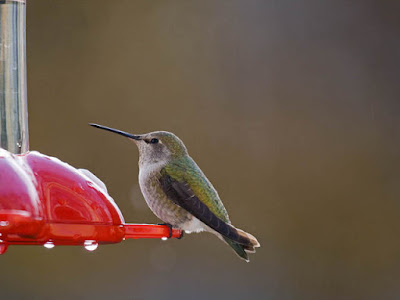 |
|
Female Anna’s Hummingbird
Photo by Greg Gillson
|
What possible bad can come to hummingbirds from feeders?
Science writer Anita Sanchez has an article on her blog that plainly states her sentiment. The article is entitled, “Why hummingbird feeders are a terrible idea.” (source) She has two main arguments against feeding hummingbirds.
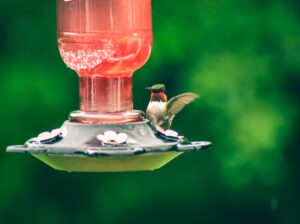
Red food coloring
The first reason Sanchez lists for saying that hummingbird feeders are bad for hummingbirds is the growing possibility that red food coloring may be harming hummingbirds.
The Audubon Society’s Hummingbird FAQs (source) recommends against adding food coloring to hummingbird nectar. Its brief reason is that red food dye “could” be harmful to birds.
What does the Hummingbird Society have to say about red food coloring? (source) Well, its page on feeding hummingbirds gives the recipe to make it yourself and then has the words in bold: “No red food coloring!” with no further explanation.
Red dye number 2 (Amaranth) was banned in the United States in 1976 (Wikipedia article here). Its use was replaced by Red dye number 40 (Allura Red AC) (Wikipedia). There is no definitive proof that red food coloring is bad for hummingbirds. Nevertheless, coloring the hummingbird nectar red is not necessary. Hummingbirds are attracted to the color red and red flowers. Most hummingbird feeders have red feeder ports or decorations that are ample to get the birds’ attention and interest.
Some commercial hummingbird nectars contain red food dye. But making your own hummingbird food is both easier and cheaper. There’s no need to add red food coloring. Since most recipes advise against adding food coloring, the practice of doing so is becoming less common. Since you have complete control over whether your hummingbird food has dye or not, I don’t consider this a valid reason not to feed hummingbirds.
Not keeping the feeder clean
Sanchez’s second argument that feeding hummingbirds is bad for them has to do with feeder cleanliness. She says she’s too lazy (her words) to keep her feeders clean on a regular basis. Here, I’d have to agree with her. If you are unwilling to wash your hummingbird feeder to keep diseases away, then the hummingbirds would be better off without your feeders.
The hummingbird nectar may become cloudy with bacteria. Mold may grow on the inside of the feeder. Thus, feeders need to be cleaned often.
The Audubon article mentioned above recommends cleaning 2 times per week in hot weather, once per week in cooler weather. It also recommends cleaning every time the feeder is emptied by hungry hummingbirds. Do not refill a hummingbird feeder without cleaning! Audubon recommends hot water, or a weak vinegar solution, rather than soap, which may leave a harmful residue.
The Hummingbird Society says to use mild detergent (not soap). Okay, there’s a difference that I’ve always wondered about. The dishwashing liquid I use to hand wash the dishes is evidently a detergent (as is the laundry detergent), while the hand soap (bar or liquid) is a soap. Soap contains fats (animal or vegetable). So it’s okay to use liquid dish soap detergent to clean the hummingbird feeders. Rinse well.
When choosing a hummingbird feeder look for one with a wide mouth that allows you to reach inside with a scrub brush. Find one without many nooks and crannies that are difficult to clean. Some hummingbird feeders are dishwasher safe and may be more thoroughly cleaned this way every so often.
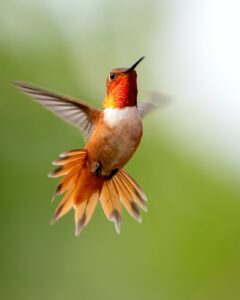
What other problems can cause hummingbird feeders to be bad for hummingbirds?
Over at The Spruce (source) writer Melissa Mayntz mentions two other hummingbird feeder mistakes that can be bad for hummingbirds.
Using the wrong sweeteners for hummingbird food
The only acceptable human-provided hummingbird food nectar contains refined white sugar. You may personally believe you consume too much overly-processed foods and sugar. However, refined white sugar is pure sucrose diluted with 4 parts water to perfectly match the nectar of plants upon which hummingbirds feed.
As Mayntz notes, using any other sweetener besides sugar is bad for hummingbirds. Raw sugar, molasses, and honey are especially bad for hummingbirds. These either directly impact the health of hummingbirds or encourage the growth of other pathogens detrimental to hummingbirds.
Candidiasis is an infection from fungus that hummingbirds get from unclean hummingbird nectar. It develops quickly in nectar made with honey. Never feed hummingbirds honey! It is the same yeast that causes vaginal infections and the disease thrush in humans. In hummingbirds the tongue swells and won’t retract. It is almost always fatal in wild hummingbirds.
Sugar content in natural flower nectar does vary. But homemade nectar in your hummingbird feeders should stick close to 1 part sugar to 4 parts water. [See my article on hummingbird food nectar recipe.] Less sugar than the 1:4 ratio and hummingbirds won’t be attracted to the feeders. More than 1:3 sugar to water ratio is too strong and is bad for hummingbird liver and kidneys. Higher sugar concentrations may also spoil more quickly, as Mayntz notes.
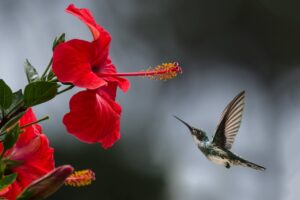
Hummingbird feeder insect pests
Hymenoptera are insects that include wasps, bees, and ants. Most species can sting, as well as bite. These are the primary competitors of the hummingbirds for your hummingbird food nectar.
Bees and wasps can be kept away from hummingbird feeders by the design of the feeding port. The hummingbird nectar should not be near the opening. Thus, only the long bill and tongue of the hummingbird should be able to reach down through the feeding port to the liquid.
Bees are attracted to yellow, hummingbirds to red. Choose a hummingbird feeder with red and no yellow, especially at the feeding port.
Hummingbirds eat small insects, such as fruit flies and gnats. Apparently, though, they don’t have an appetite for ants. Ants can quickly take over a feeder and keep hummingbirds away. Because ants are small they can crawl down and reach the nectar. Some hummingbird feeders have an ant moat–a cup of water with hooks between the hanger and the feeder. [If you are curious, here is a link to ant moats on Amazon, where you can see various types and price them.]
Insects can quickly contaminate the nectar in hummingbird feeders and should be eliminated.
The argument against the position that hummingbird feeders are bad for hummingbirds
Above I discussed four main arguments given for the position that hummingbird feeders are bad for hummingbirds. I summarize these four arguments below and counter-argue that all these points are easily remedied.
1. People point to the possible harm of red food dye to hummingbirds. Whether true or not, red food coloring is totally unnecessary when making hummingbird food. Most commercial hummingbird foods do contain red food coloring. Don’t buy them. Make your own hummingbird nectar. It is cheap, quick and easy.
2. Keeping the feeder clean is always a challenge. However, if you fill the feeder with only the amount of nectar that hummingbirds will consume in 3-4 days, it will always disappear before it goes bad. If you have 2 feeders and alternate refilling days, your hummingbirds should rarely run out of food. Then be determined never to re-fill a feeder without washing it first.
3. The wrong hummingbird food recipe can harm hummingbirds. Yes, this is true. So, don’t substitute ingredients when making hummingbird nectar. 1 part refined white sugar to 4 parts water. That’s it.
4. Insect pests can drive hummingbirds away from the feeder and contaminate it. Yes, true. Many hummingbird feeders are designed to keep out bees and wasps by moving the nectar away from the feeding port so that only hummingbirds can reach. Ant moats work quite well to keep ants away. Ant moats need to be refilled with water nearly every day.
So, with some determination and forethought on your part, you can safely feed hummingbirds. As the Audubon FAQ states, there really is no downside to feeding hummingbirds. We can supply nectar to the hummingbird’s diet, perhaps at a time of year when natural nectar sources are scarce.
Follow the four guidelines here and enjoy feeding hummingbirds with peace of mind!
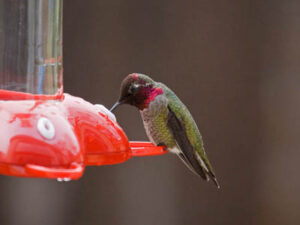
Wrapping Up
Feeding hummingbirds offers several benefits, both for the hummingbirds themselves and for the broader ecosystem:
Benefits for hummingbirds:
- Supplemental food source: Hummingbirds have incredibly high metabolisms and require constant energy intake. Feeders can provide much-needed nourishment, especially during times of scarce natural nectar sources, like dry spells or cold weather.
- Attract diverse species: Different feeder designs and nectar variations can attract a variety of hummingbird species, enriching your backyard or garden with their vibrant presence and mesmerizing acrobatics.
- Reduce competition: Feeders can offer an additional food source, potentially easing competition for natural nectar sources and reducing stress on these highly energetic birds.
- Observation opportunities: Hummingbird feeders provide fantastic opportunities to observe these fascinating creatures up close, allowing you to appreciate their unique adaptations and feeding behavior.
Benefits for the ecosystem:
- Pollination: Hummingbirds are vital pollinators for many flowering plants, including native species crucial for ecosystem health. By providing them with nectar, you indirectly support plant reproduction and contribute to a healthy, diverse ecosystem.
- Pest control: Some hummingbird species occasionally consume small insects while feeding, contributing to natural pest control and benefiting the plants in your garden.
- Conservation awareness: Attracting and observing hummingbirds can spark interest in these remarkable birds and inspire people to learn more about their conservation needs and habitat protection.
Frequently Asked Questions
When should you stop feeding hummingbirds?
The decision of when to stop feeding hummingbirds can be a bit nuanced and depends on several factors, including your location, climate, and the behavior of the birds themselves. Here are some key things to consider:
Local hummingbird presence:
- Migration patterns: In areas where hummingbirds are migratory, their natural food sources will increase as flowers bloom in their summering grounds. Once you notice a significant decrease in hummingbird visits at your feeders, it’s likely an indicator that they’ve begun their migration journey.
- Resident species: If you have resident hummingbird species in your area, they may rely on feeders throughout the year, especially during harsh weather periods. You can continue feeding them year-round if they continue to visit regularly.
Climate and natural food sources:
- Temperatures: As temperatures drop in autumn and winter, natural nectar sources dwindle. If natural food sources are scarce, consider continuing to provide feeders as a supplemental source of energy for resident hummingbirds.
- Blooming plants: Observe the blooming patterns of native plants in your area. If enough flowers are available for hummingbirds to forage from, you can gradually reduce the frequency of filling your feeders, eventually stopping altogether.
Hummingbird behavior at your feeders:
- Visits and activity: If you notice a significant decrease in visits to your feeders and the remaining hummingbirds seem listless or uninterested in the nectar, it may be time to stop feeding. This could indicate they’ve found other food sources or are preparing for migration.
- Feeding aggression: Increased competition or aggression at your feeders can be a sign that natural food sources are becoming more available. This can also be a cue to gradually reduce or stop feeding, allowing them to transition to natural sources without relying solely on feeders.
When do hummingbirds leave the US?
Hummingbird migration in the US is a complex affair, with different species following diverse timelines and routes. Here’s a breakdown:
Hummingbird Migration Seasons:
- East Coast: Most eastern hummingbird species, like ruby-throated hummers, migrate south from late August to early October. They winter in Central America and northern South America, returning north by early April.
- West Coast: Western species like rufous hummers may start migrating south as early as July, with most departing between August and September. Their wintering grounds vary, with some reaching Mexico and others venturing all the way to Costa Rica. Some western species, like Anna’s hummers, are year-round residents in certain areas.
- Rocky Mountains: Hummingbird migration in the Rockies follows a similar pattern to the East Coast, with most species departing south between August and October.
- Southwest: Some Arizona and New Mexico species like broad-tailed hummers are migratory, while others like Anna’s and Costa’s hummers are resident.
Factors Affecting Migration:
- Daylight hours: Shortening daylight triggers the urge to migrate and find areas with better food sources.
- Temperature: Cooler temperatures on breeding grounds also play a role, especially for species in the north.
- Food availability: Declining flower blooms and nectar sources in summer areas push these tiny birds south.
Observing Hummingbird Migration:
- Decreased feeder visits: As migration nears, you might notice fewer visits to your hummingbird feeders.
- Change in behavior: The remaining hummingbirds may appear restless or less interested in feeding.
- Shifting vocalizations: Some species may increase their chirping or display flight patterns associated with migration preparation.
Read next: Recipe: Hummingbird food: Steal your neighbor’s hummingbirds!



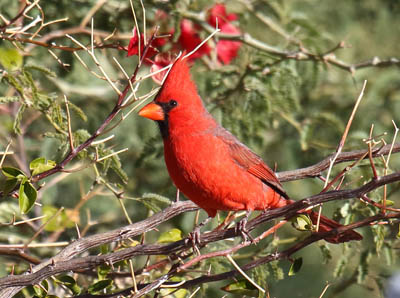
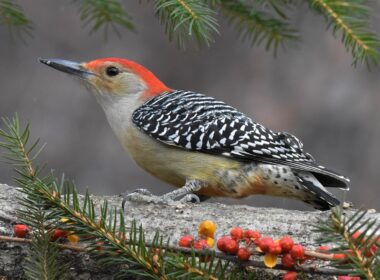
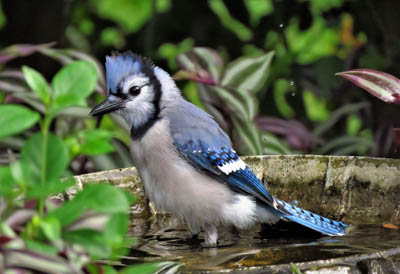
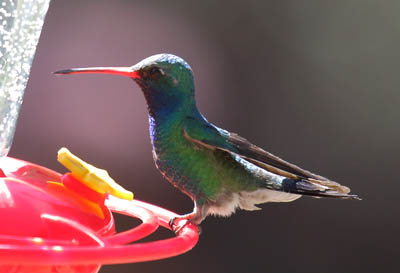
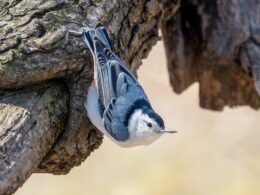
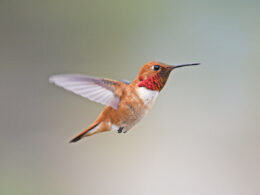
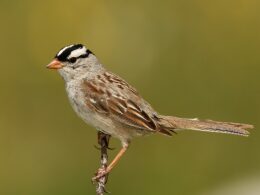
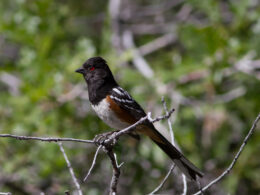
Thanks Greg. Great information. Exactly what I was looking for.
You are welcome, Rich. Glad I could help.
Thanks for this info. I use lemon eucalyptus to repel mosquitos is this something that can hummingbirds or keep them away from our feeder?
I don't think it will bother the birds.
Most birds actually have a poor sense of smell (notable exception turkey vulture, Australian kiwi, some seabirds).
If we provide easy food for the birds will this make them dependent and less likely to search for other food?
No, birds eat a lot of food and are always on the look out for more food sources, because it is so transitory. And many birds are territorial and will try to claim a territory to keep other birds out.
I have a red glass feeder. Is it okay to use and should it be placed in the shade or sun?
It is good to use.
Morning sun, afternoon shade is likely best. I discussed this topic here: https://whatbirdsareinmybackyard.com/2019/09/where-should-hummingbird-feeders-be-placed-in-sun-or-shade.html
I recently settled up a hummingbird feeder and decided to get a hummingbird umbrella to keep the afternoon soon getting too much heat. I also made my own drink recipe with pure cane sugar unrefined and water. I slightly dissolved the sugar granules and the hummingbirds love it. I am glad to read about cleaning it weekly. I don’t want to harm the magnificent birds. ❤️ I get them visiting often and have it hanging over the balcony on a hook. No issues with bugs and ants.
Hmm… hummingbird umbrella. Good idea. But how do you protect from wind?
Kiwi birds are New Zealand birds, not Australian.
Yes, you are so right. Can I claim that I was talking about the continental whole rather the country? No? Then how about senility?
Great site. I had checked another site that had the sugar water ratio as 3:1 is there a big difference and why
Just wanted to add I noticed a big difference in how long the nectar stays fresh by moving it out of sunlight. It’s now on the north side of my porch, under an eave, that gets less than an hour of sun, and it’s late evening sun so not that strong. I can double the amount of nectar now and have it gone in 4 days. The little piggies by me were finishing 8oz in 2 days. Just wish they’d all get along. East coast hummingbirds are so territorial, I keep telling them there’s enough for everyone but they don’t listen lol. 🤪
4:1 is the normal ratio. 3:1 is an allowable one that may attract hummingbirds more readily. Once they start coming though, 4:1 is fine. 4:1 is 20%, 3:1 is 25% sugar. Natural flowers can be that high at times.
New post: Hummingbird Fighting Over Feeders (what you can do)
https://whatbirdsareinmybackyard.com/2022/06/hummingbirds-fighting-over-feeders.html
Can I use peppermint oil on the hummingbird feeders to keep bees away? Will it harm my hummingbirds?
On or around the feeder ports is fine. Not in the nectar.
This late in the season the hummingbirds are habituated to coming to your feeder. You can dilute the mixture (1 part sugar to 5 parts water, instead of the usual 4 parts water). The bees may not be as attracted, but the hummingbirds will still appreciate the hydration.
Thank you for the useful information.
What to do if you go on vacation and can’t fill the feeder?
Some people take down their feeders earlier than I do, as they're afraid hummers will stay longer (too long) if they're tempted by feeders. I say as long as I still see them, I'll feed them. They're smarter than I about when to head south. Your thoughts?
When to put feeders up and when to take down feeders?
https://whatbirdsareinmybackyard.com/2019/11/when-should-i-put-out-take-down-hummingbird-feeders.html
The hummingbirds will likely return when you refill it. But this is kind of late in the season, so many will have already migrated south.
The migratory imperative is stronger than the lure of food. You probably already have noted that the colorful males already migrated south in July. It's only the juvenile birds around now.